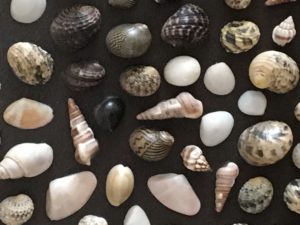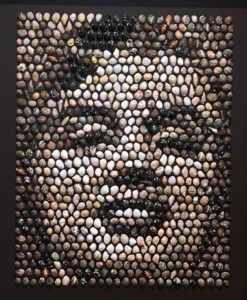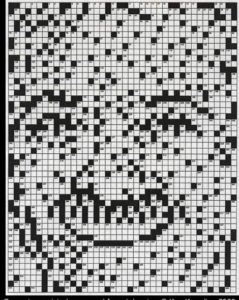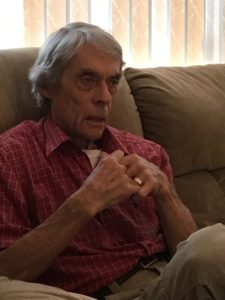Ken Knowlton is a fellow Sarasotan whom I met through mutual friends from Michigan, and who quickly made it to the top of my list of artists I wanted to feature. “improv artist” tends to suggest someone whose art is created  spontaneously and quickly like Phil Hansen’s Mona Lisa made from hamburger grease (which is undeniably amazing).
spontaneously and quickly like Phil Hansen’s Mona Lisa made from hamburger grease (which is undeniably amazing).
Ken on the other hand, is slow and painstakingly methodical. A former scientist/researcher for Bell Laboratories where in 1963 he developed one of the earliest bitmap graphic systems for computer movie making, he sees pixel possibilities in dominoes, dice, Braille, crossword puzzles, seashells, match box cars, mixed up jigsaw puzzle pieces, and spools of thread – and has created portraits in each of those mediums. 
He first saw the possibilities in dominoes, which, depending on whether the background is black or white and how many dots are on the tile, can range from quite dark to very light. His first domino picture required 24 sets, but eventually he refined his technique to a more reasonable six sets per picture.
Then while wandering the beach with his wife on an island off Puerto Rico, he looked at the masses of washed up shells and said, “That’s a picture of somebody when you put it together right.” He filled six coffee cans with the shells and carried them around for years, until “At one point I borrowed a light meter and one by one, I measured how bright each one was.” He sorted them accordingly, but it still took a long time before he got around to making his first shell painting. Seen close up, it is a meaningless mass of shells, but back up and it is an amazingly detailed portrait. His subject matter has ranged from Benjamin Franklin to Marilyn Monroe, most of which are in private collections. Eventually he began buying shells wholesale and created his own software program to help him figure out the placement of each piece.
 Ken enjoyed suiting his medium to the person whose portrait he was creating. Thus, Albert Einstein, who once said, “God doesn’t play dice with the Universe,” was recreated using dice. Helen Keller’s portrait is in Braille. The portraits of radio “Car Talk” show hosts Tom and Ray Magliozzi, known also as “Click and Clack, the Tappet Brothers” were created with matchbox cars. New York Times crossword puzzle editor Will Shortz is depicted as a crossword puzzle.
Ken enjoyed suiting his medium to the person whose portrait he was creating. Thus, Albert Einstein, who once said, “God doesn’t play dice with the Universe,” was recreated using dice. Helen Keller’s portrait is in Braille. The portraits of radio “Car Talk” show hosts Tom and Ray Magliozzi, known also as “Click and Clack, the Tappet Brothers” were created with matchbox cars. New York Times crossword puzzle editor Will Shortz is depicted as a crossword puzzle.
Sometimes there was a story behind the portrait. In 1995 a devastating fire destroyed three main buildings of the Malden (fabric) Mills in Lawrence, MA. Owner Aaron Feuerstein kept his nearly 3000 employees on salary for the full three months it took for the factory to become usable again. Ken was moved by his magnanimous gesture and business decency and created Mr. Feuerstein’s portrait in spools of thread, then gave it to him as a gift.
 Ken Knowlton is retired now, but still fascinated by the “visual ambiguity” created by portraits that are also spools of thread or sea shells. I like to think he’ll enjoy the rest of this series.
Ken Knowlton is retired now, but still fascinated by the “visual ambiguity” created by portraits that are also spools of thread or sea shells. I like to think he’ll enjoy the rest of this series.
Read more about him at http://www.kenknowlton.com/index.htm and http://www.knowltonmosaics.com/ His work is also featured at length in Al Seckel’s book, Masters of Deception.
